
Introduction. As said in The Reinhart Legacy – Part 1, this series of articles focuses generally on the Reinhart Family's contributions to Oklahoma City, but, most particularly, upon Martin John Reinhart and the more subtle contributions of his sister, Theresa, revealed through her teenage eyes when growing up in Oklahoma City during the 1910s. This article is about Martin, her older brother. Part 3, Churches, also shows the accomplishments of Martin, and Part 4 focuses on the scrapbook of Theresa.
Martin is the "Quiet Builder" identified in the above April 20, 1949, Daily Oklahoman article.
The article says,
A short 67-year old man stepped up to receive a life membership in the state section of the American Society of Engineers Tuesday night. The little man, a former professor at Iowa State college [Iowa State University, today] came to the dinner only after receiving a promise he would not be asked to speak.Many Oklahoma City fathers' and mothers' names are almost household names to Oklahoma Citians who have a care for history, and some who don't. Those people have things "named" after them – Henry Overholser the Overholser Mansion and his son and former mayor, Edward, for Lake Overholser; "Couch Drive" for our 1st mayor; the Colcord Hotel for Charles Colcord; Perle Mesta for Mesta Park; and, yes, even the Flaming Lips for the "Flaming Lips Alley" in Bricktown. Such a list could go on and on.
There was nothing out of the ordinary about the ceremony. Life memberships are awarded to engineers who have been a member of the society for 35 years. His years of service were lauded in the usual complimentary phrases. There was nothing unusual about the affair – except the man. He is Oklahoma City's least publicized multi-millionaire.
His name is M.J. Reinhart. You probably don't know him. But you have seen his mark.
What was said in the 1949 article remains true – you probably don't know him. As the "Quiet Builder," you'll find no monuments, lakes, streets, or anything else in the public eye which will identify him by name. I didn't know him, either, until Norman Thompson arranged for me to shake his hand and have a look back through his history.
And, what a fine, proud, history it is for him, and for all of us today. Many of you already know about Court Plaza, or the Biltmore Hotel, or the Medical Arts Building (100 Park Avenue), or City Center (Tradesmen's Bank), or Little Flower and Our Lady's Catholic Churches. But, you may not know that Martin Reinhart built them all and many others. Read on, if you want to know more about this "Quiet Builder" whose company was one of the early-day building blocks that helped form the Oklahoma City that we know today.
The Beginnings. Martin and his wife, Josephine, and Josephine's sister's (Rose) husband, Daniel Edward (who apparently went by "D.E.") Donovan, were the 1st of the Reineharts to move to Oklahoma City, in 1907 or 1908 (Norman reports the date as 1908; D.E.'s October 8, 1944, obituary says that he moved here in 1907). Martin and Daniel formed a company, Reinhart & Donovan, and it advertised the Daily Oklahoman as early as 1909, as shown by combined snippets of Daily Okahoman ads as follows . . . larger image not available ...
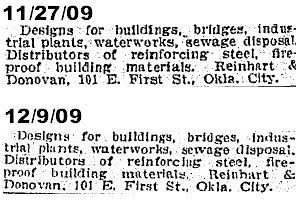
Martin's father, John, moved to Oklahoma City with his wife, Amelia, together with Martin's sibling in 1910. Norman Thompson reports that Martin's father, John, funded the contracting and civil engineering company, but whether that was so when Martin moved to Oklahoma City a couple of years earlier, I don't know. In any event, Martin's sisters, Agnes, Mary, Margarete, and Theresa, owned an interest in the company. Norman reports that eventually Martin bought Mr. Donovan's interest but when that happened is not clear – if the Oklahoman's obituary is correct, he was still involved with the company in 1931-1932 when the Biltmore Hotel was constructed, but that may not be so. Martin appears to have been the "face" of the company – his name appears in several Oklahoman articles but D.E.'s does not. Norman says that D.E. is not considered within the Reinhart extended family as having had that much to do with the company.
The Religious Legacy. As explained in Part 1 of this series, Norman Thompson advised that the Reinharts initially immigrated to the United States from Germany in the 1800s to avoid religious persecution of Roman Catholics. It was natural enough that Martin Reinhart and his family, devout Catholics all, would be involved with the construction of beautiful edifices for the Roman Catholic Diocese of Oklahoma. The first such contribution by Reinhart & Donovan was construction of St. Joseph Cathedral's two-story and basement parish house in 1912. In 1923, construction began on Our Lady of Perpetual Help parish church at N.W. 37th and Land. It was formally dedicated in October 1924 by the Rt. Rev. Francis Clement Kelley as his 1st official act as the Oklahoma Diocese's new and second bishop. Our Lady's became the diocese's cathedral church in 1931, replacing the downtown St. Joseph's. The next remarkable building constructed by Reinhart & Donovan was Church of the Little Flower and Our Lady of Mount Carmel at 1007 S. Walker, formally dedicated on March 24, 1927. Both of these churches will receive much more attention in Part 3 of the Reinhart Legacy, but, for now, here's a preview.
Our Lady's During Construction
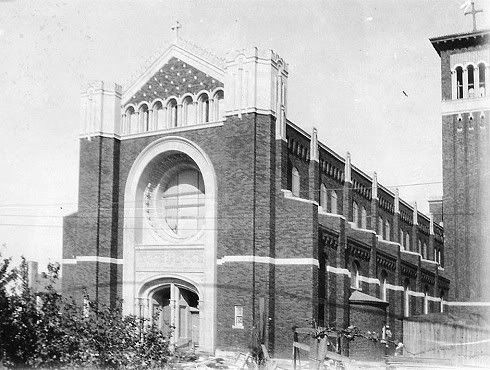
Announcement of the formal dedication
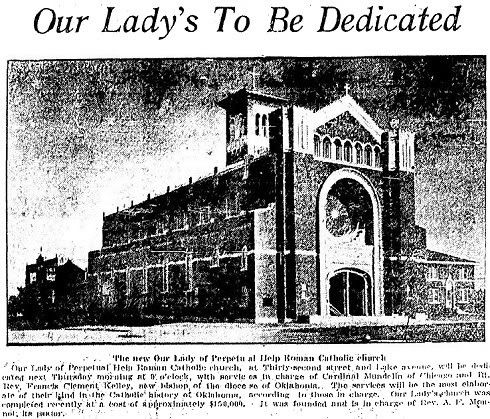
An outside photo taken in 2007

Cornerstone at the northwest corner of the building
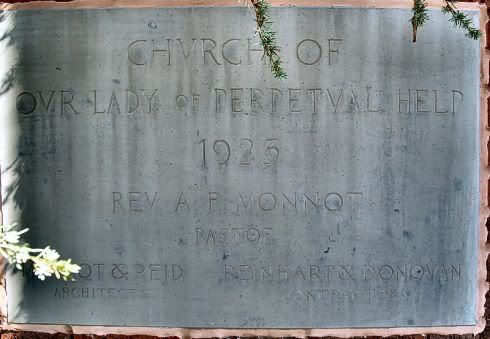
Some crops from Little Flower's March 24, 1927, Dedication Booklet

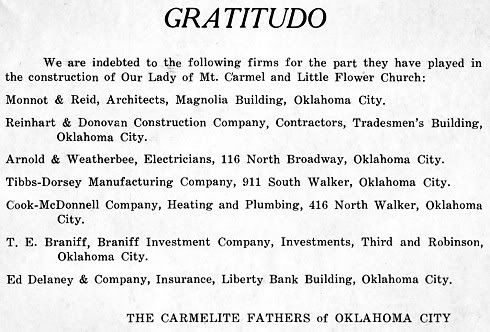

If you've never been inside of Little Flower, here's
a preview of what you'll see in Part 3 of this series.
It will knock your socks off!
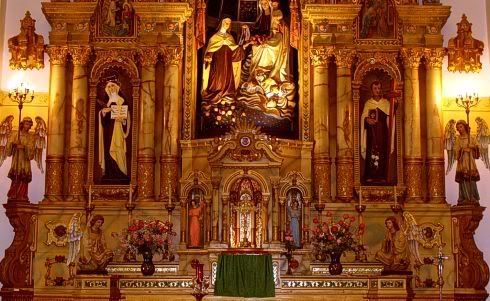
The Commerical Legacy. The 1st Daily Oklahoman item which noticed a contract award to Reinhart & Donovan was on August 29, 1911, buried in a longer article . . .

They were probably glad to have the $611.96, not such a small sum almost 100 years ago!
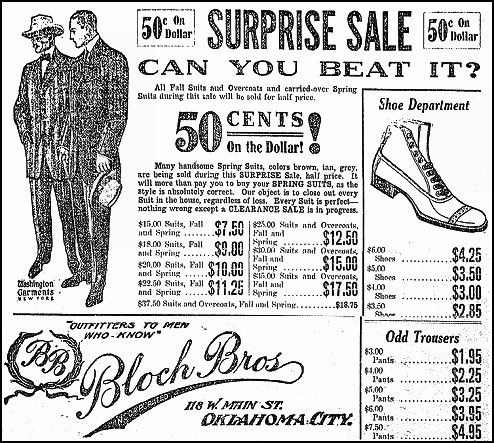
A couple of months later in 1911, company ads were a bit bolder . . .
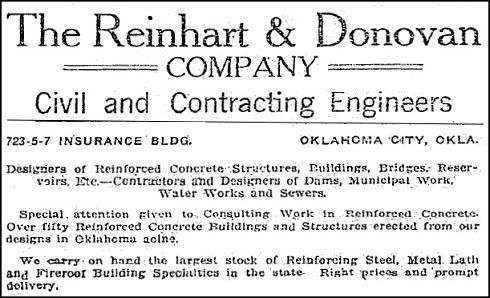
Reinhart & Donovan officed at the Insurance Building for a time
From Vanished Splendor (I) by Jim Edwards & Hal Ottaway
The Insurance Building, built around 1910 south of the Skirvin,
is roughly Chase Bank's location today
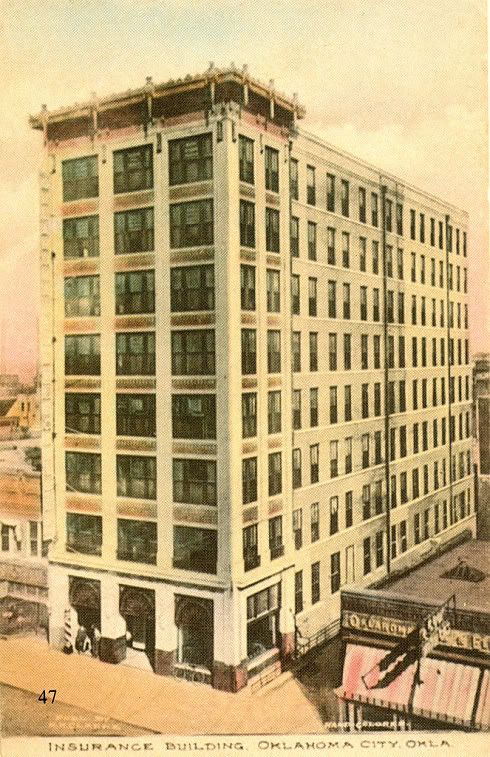
The company's earliest Oklahoma City building of note appears to be the 1914 Security National Bank at 109 N. Broadway between 1st Street (Park Avenue) and Main:
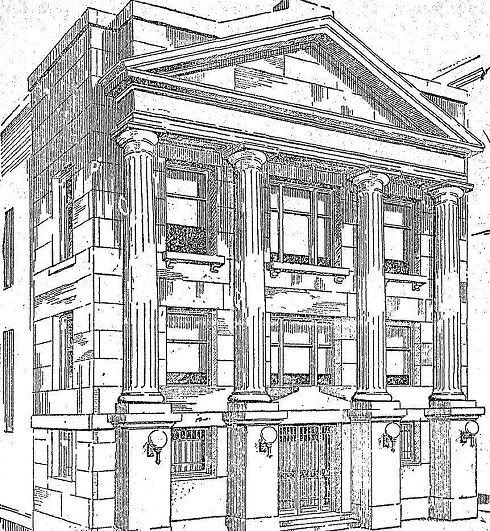
From Vanished Splendor II by Hal Ottaway & Jim Edwards

Security National's location is better shown in an image of the Tradesmens National Bank shown a few buildings below.
Next would come the 1916 Liberty Theater located in the 100 block on N. Robinson just north of the Colcord and approximately where the Internal Revenue Service building is today. In later years, the Liberty would become the Harber, and, last, the Cooper Cinerama where I first saw Stanley Kubrick's 1968 masterpiece, 2001: A Space Odyssey. The building was a 1975 victim of Urban Renewal.

Click on the images below for larger views
The Liberty in 1926
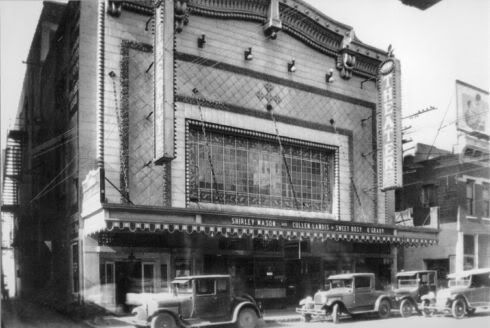
The Liberty in 1937 (left from the State)
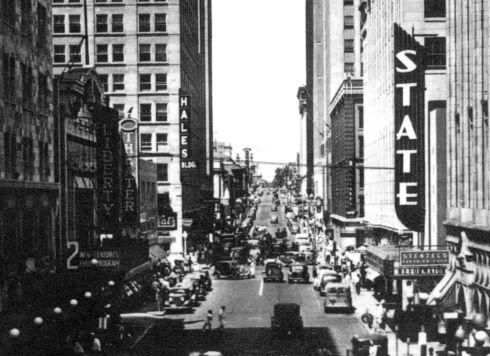
In 1919, the company started construction on the Mideke Supply Company Building in Bricktown at 100 E. Main in the warehouse district, Bricktown today. The building opened its doors in 1920 and it still stands, as shown in the current photographs, below.

The Building On June 8, 2008
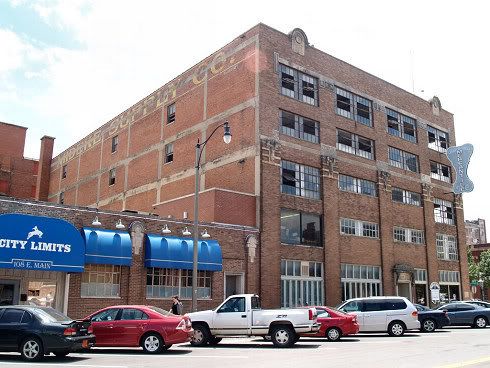
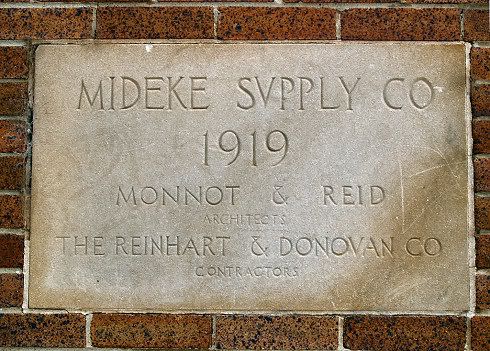
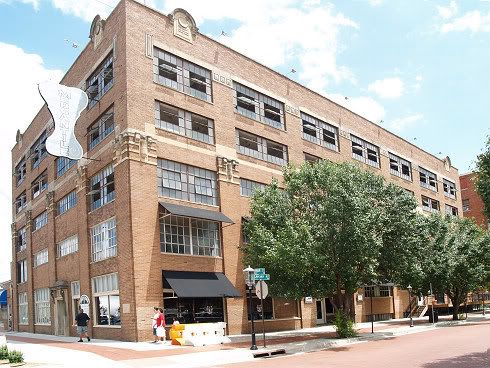
In 1921, the company built one of its most impressive and enduring buildings to date, the Tradesmens National Bank at the northwest corner of Main and Broadway. That building later became City National Bank and is the City Center Building today. Once built, Reinhart & Donovan moved its offices there. In the company's July 17, 1921, Oklahoman ad associated with the grand opening of that building, Reinhart & Donovan proudly showed other buildings it had built as of that date, not all in Oklahoma City:

Click the images below for a larger view
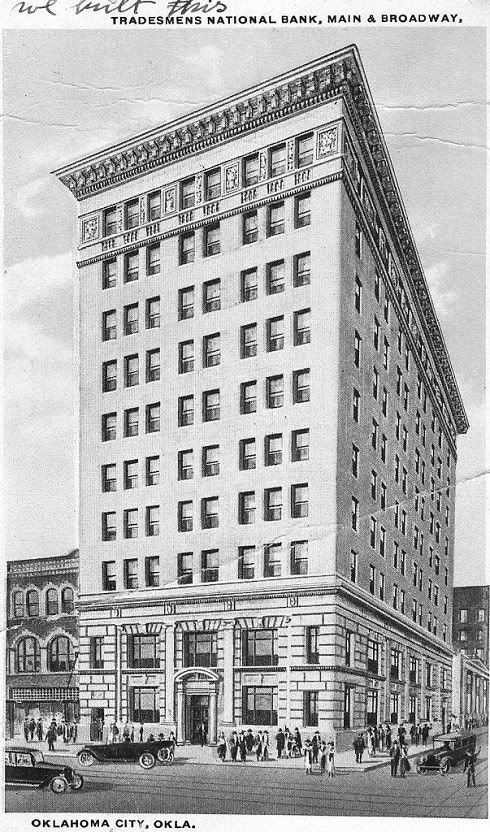
Originally Tradesmens National, it is the City Center today
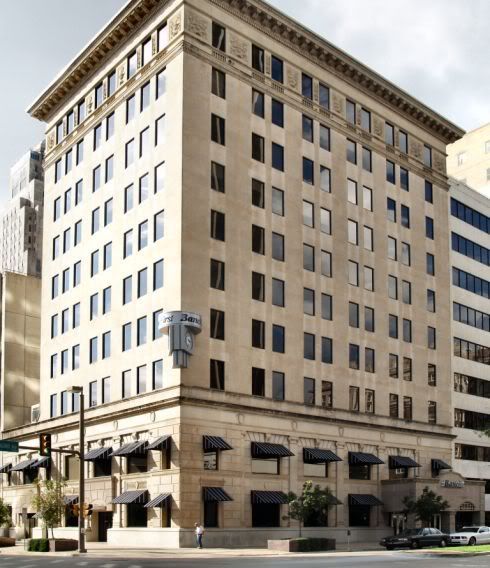
In this Vanished Spendor II vintage postcard,
notice Security National Bank's location, north of Tradesmens
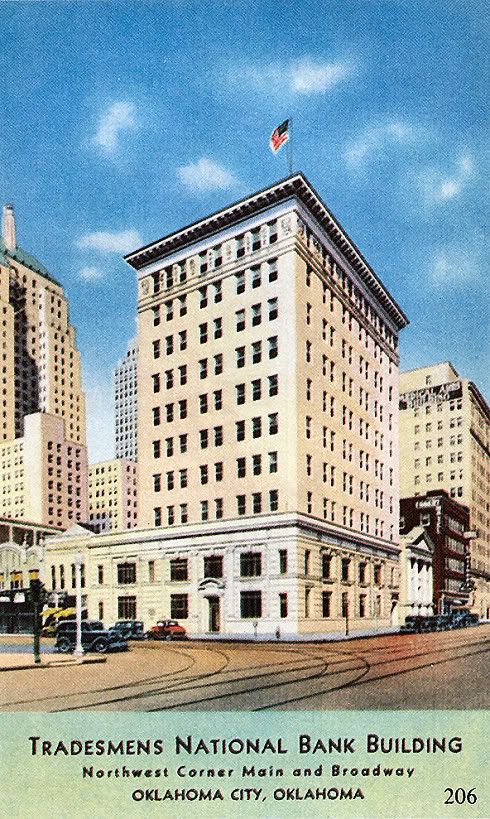
Notice in the above postcard, too, the white building at the end of the same block – that is the Medical Arts Building built by Reinhart & Donovan – I'll get to that building shortly.
The 1921 ad showed pictures of three buildings elsewhere, the First Christian Church in Ft. Worth and a pair of buildings at the A & M College, Stillwater: the Science Building and the Armory Gymnasium Building.
The 1914 First Christian Church in Ft. Worth is still going strong and was listed in the National Register of Historic Sites in 1983. It is seen in a contemporary photo below from that church's website:

Postcard views of the OSU buildings identifed in the ad are shown below (larger images not available):
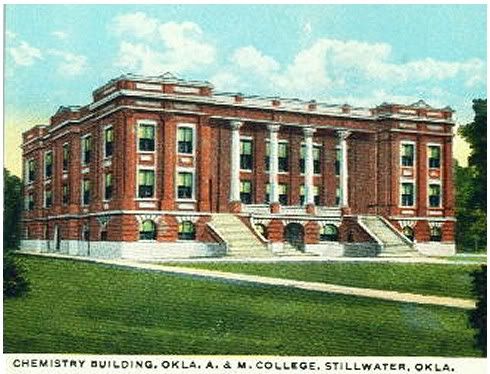
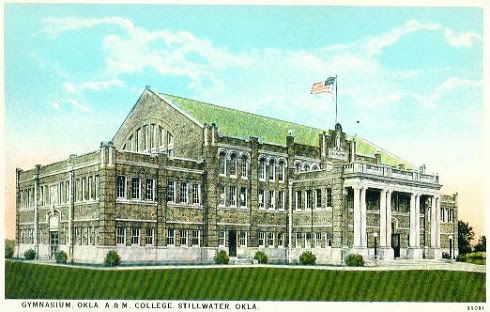
Reinhart & Donovan was clearly on a roll. Here's a cool ad from the September 23, 1923, Daily Oklahoman (larger image not available):

By 1925, Reinhart & Donovan could rightly claim construction of almost the entire west side of Broadway between 1st Street (Park Avenue) and Main when it constructed the Medical Arts Building, today called 100 Park Avenue. It didn't build the Egbert Hotel (the 5 story red brick building shown in the Vanished Splendor II Tradesmens National Bank postcard, above) but the company did own an interest in Bishop's Restaurant located in its first floor. The company's ad associated with this building's April 26, 1925, opening is shown below (larger image not available):

Click the images below for larger views
During Construction -- The Egbert Hotel,
home of Bishop's Restaurant, is at the left

When Completed
Courtesy Buddy Johnson, Oklahoma City Metropolitan Library System
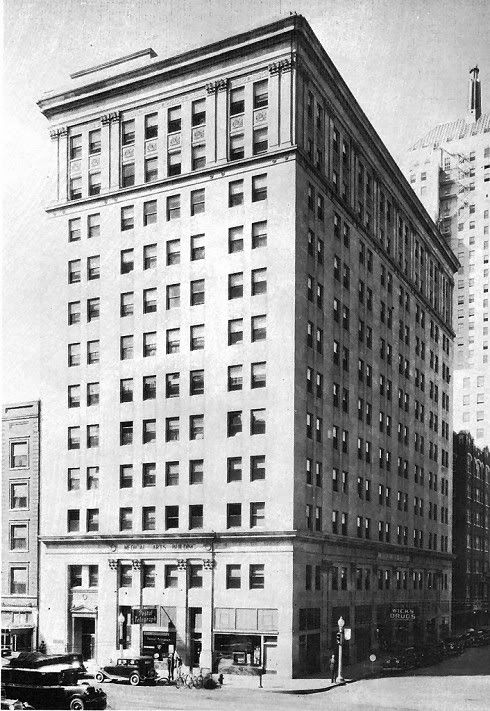
Here's the same building today, 100 Park Avenue Building
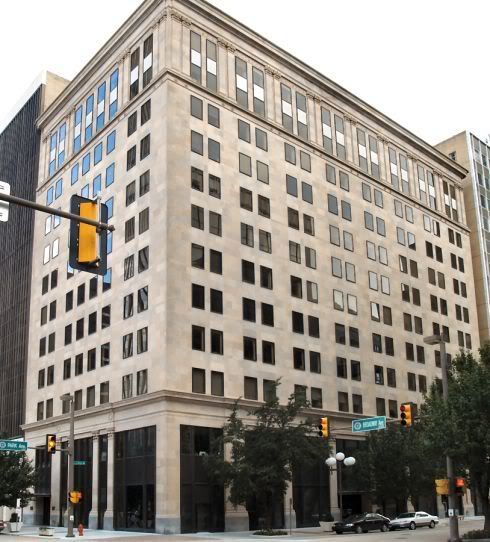
Having done the Medical Arts Building in 1925, Reinhart & Donovan proceeded to build the city's first "Auto Hotel" next to it in 1927. Here are the splashy two-page ads in the February 13, 1927, Daily Oklahoman ...
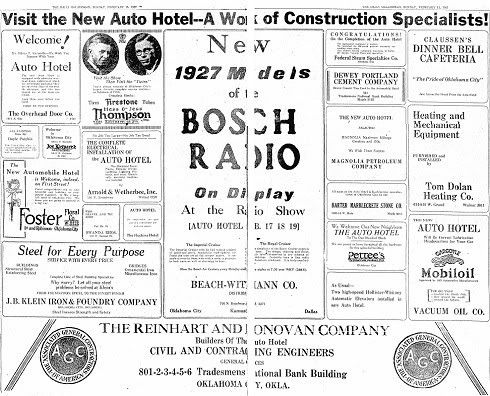
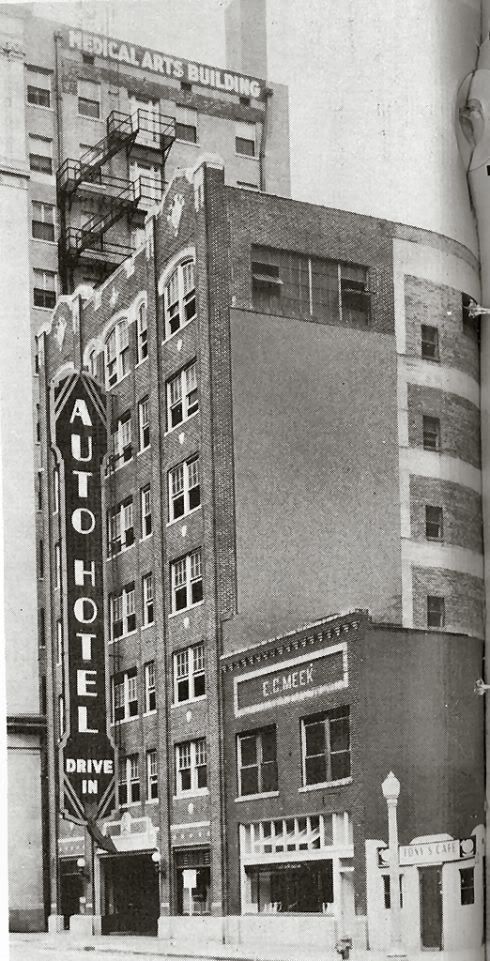
1957 Photo from 1st National Archives
after completion of its first east-side expansion

The building gave way to 1st National's second east-side expansion in 1972. For a time, Reinhart & Donovan's offices were located in the top floor of the two-story part on the building's west side.
The company did smaller jobs, too. Here's an August 3, 1927, Oklahoman ad showing the Brousseau & Stapp Sinclair/Firestone auto service station constructed on the southeast corner of NW 5th & Hudson in 1927 and a photo showing the same property today ... a larger image is unfortunately not available so that you can better see this vintage photo ... OG&E is being constructed in the right background:
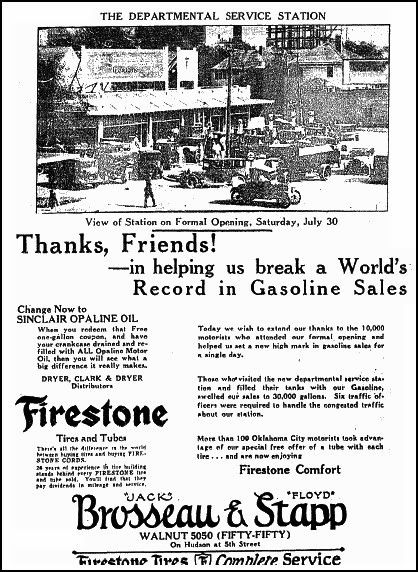
Here's another on July 30, 1927 ... larger image available
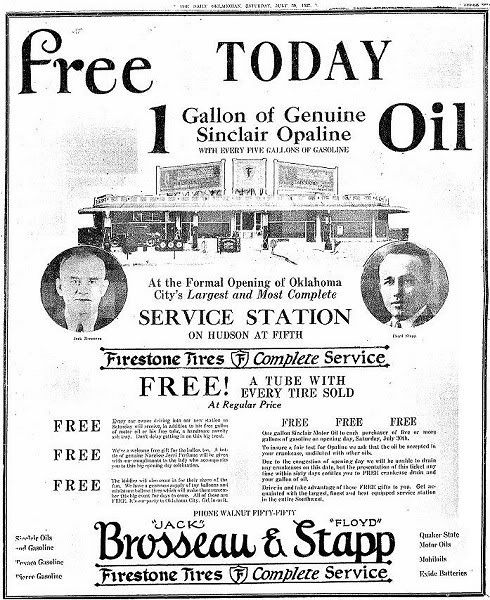
Here's the same building in a photo taken in 2007
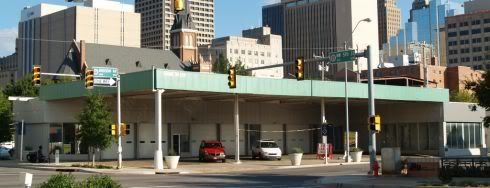
But the most enduring 1927 accomplishment was Reinhart & Donovan's construction of Oklahoma City's 1st residential shopping center, the Plaza Court at Walker & N.W. 10th. The grand opening ad was announced in this splashy November 20, 1927, Oklahoman ad ...
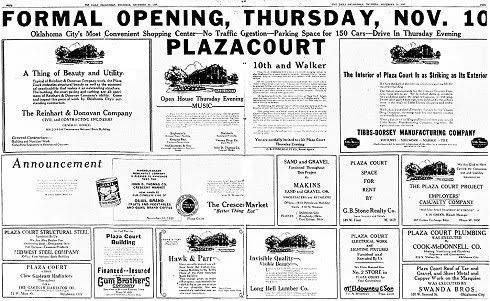
Plaza Court Today
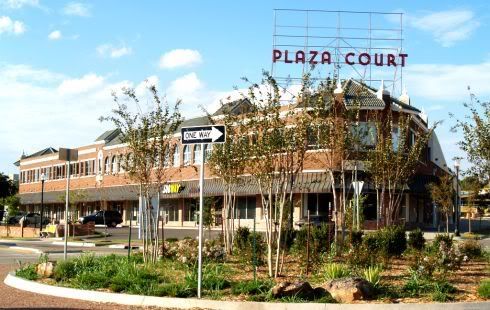
The fabulous Crescent Market was among Plaza Court's initial tenants. Of course, this building has been revitalized today by Greg Banta and his Banta Companies as part of their sweeping Midtown redevelopment program which is on-going on as we speak.
The next major project of Reinhart and Donovan was 1928's Commerce Exchange Building located at the southeast corner of Grand and Robinson. The company and many major tenants, including the Chamber of Commerce which moved their offices to the top two floors in September 1928. A July 7, 1925, Oklahoman article reported that it was to have been seventeen stories but when done in 1928 it turned out to be ten. Although no "grand opening" ads appeared in the Oklahoman for this project, on July 22 the following did appear:
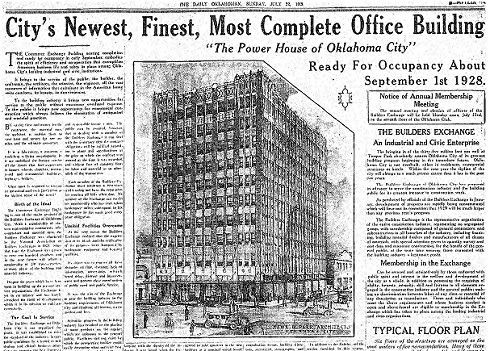
The building was destroyed during the 1970s Urban Renewal.
Here's a better image
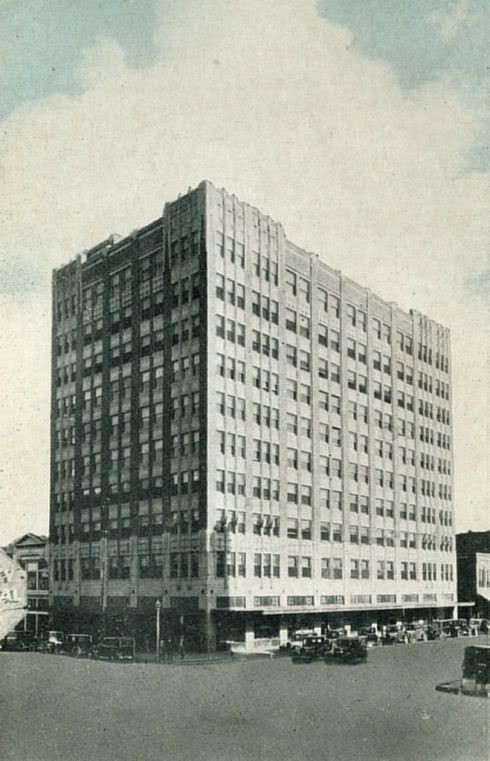
By the end of 1928, Oklahoma City was downright giddy about all the downtown construction and elsewhere in the city. The following Oklahoman article gives a nice summary for the year, and for projects either planned or started but not yet done – click on the article for a readable view.

A January 6, 1929, Daily Oklahoman pictorial showed some of the buildings more vividly:
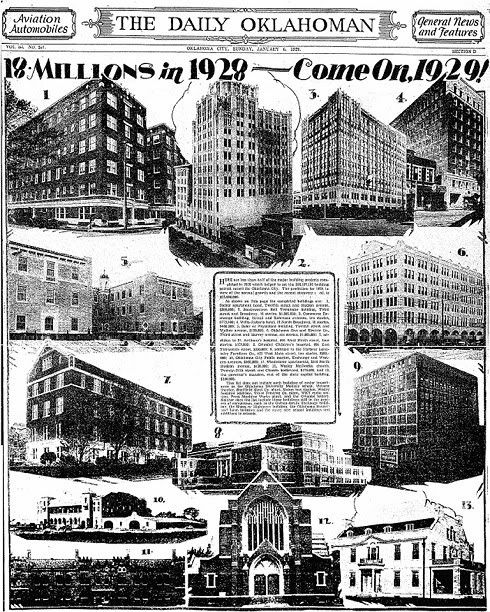
Here's the same image with names imposed
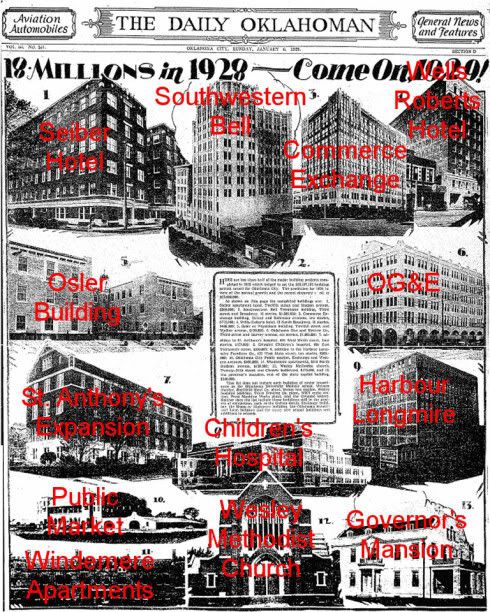
Notice Building #5, above, the 3-story Osler Building at 1200 N. Walker. Whether Reinhart & Donovan built that initial 1928 structure, I don't know, but it did build the 3-story addition in September 1929, after the above article was written. I don't have an older photo but here's one I took in 2007 (but with a top floor later added at a time I do not know):
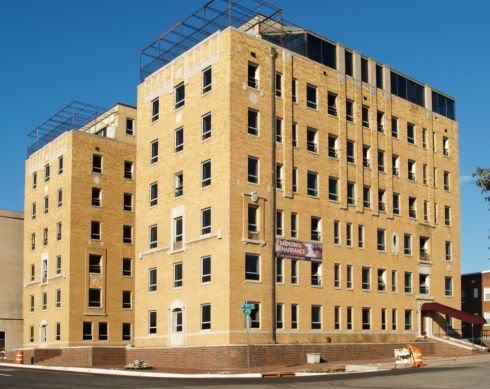
In 1930, Reinhart and Donovan added the Midwest Building, which housed the Midwest Theater, at 16 N. Harvey.
August 1, 1930, Oklahoman ad
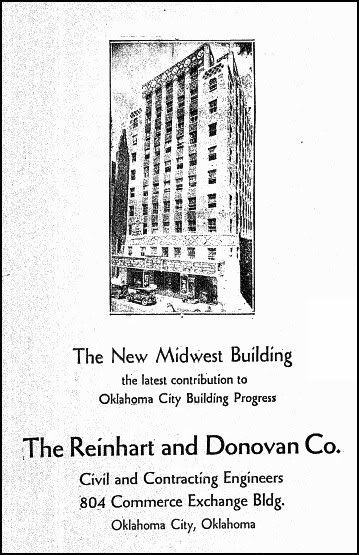
1970 photo with credit to Jeff Chapman
Click the photo for a larger view

Despite Wall Street's "Black Thursday" (October 24, 1929), by early 1931, neither Reinhart & Donovan nor Oklahoma City had missed a step, just yet. As late as September 27, 1931, optimism remained the modus operandi of the time ...
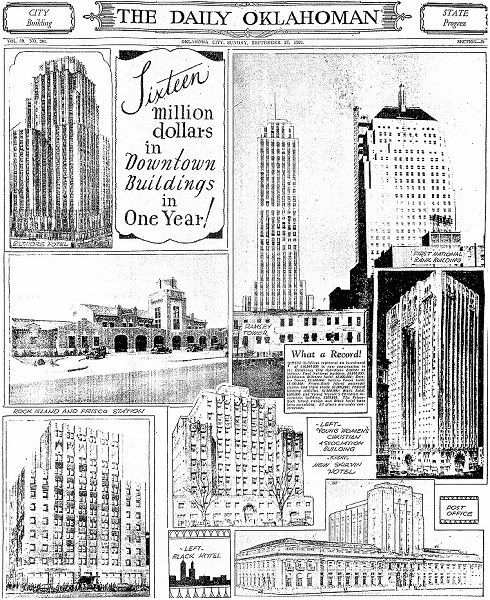
Same image but with building names superimposed
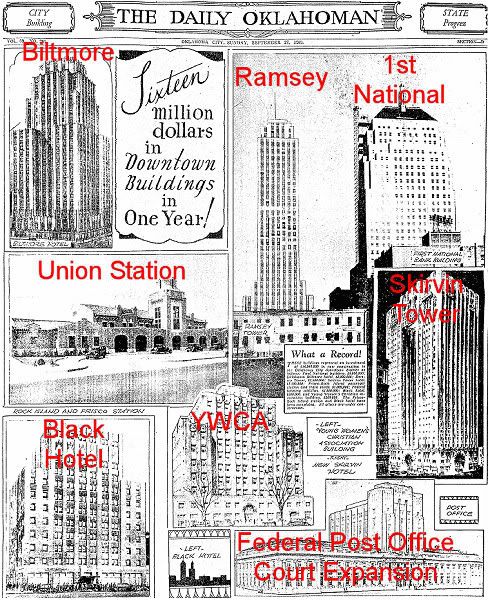
By this time, the Ramsey Tower and 1st National were nearly done as were other major items of construction. Notice a couple of things in the above – the Skirvin Tower Hotel, still planned to be 26 stores (right), and the new 26 story Biltmore Hotel which was about to get started. The YWCA got done (1931), and the Post Office & Federal Court expansion was done in 1932. 1931-1932 marked the end of a tumultuous downtown building boom – in addition to those already mentioned, others were built in this 4 or 5 year zone: Petroleum (now Dowell Center, 1927), Perrine (now Robinson Renaissance, 1927), Wells Roberts Hotel (1927), Oklahoma Savings & Loan (presently part of the Sandridge campus, 1928), OG&E (1928), and Hightower (1929).
Back to topic. The 26 floor Biltmore Hotel was to be the greatest and largest of Reinhart & Donovan's construction ventures, it being awarded the status of general contractor in 1929. The same issue of 1931 the Oklahoman, above, showed this drawing (no larger image available):

The project was described in a January 11, 1929, Oklahoman article:
The preliminary plans call for the erection of a 600 room hotel to accommodate 1,200 guests. The building will be designed to permit the addition of 200 rooms at any time. * * * The Oklahoma Biltmore will be at Harvey and Grand avenue, and will cost between $3,000,000 and $4,000,000, depending on final plans. It will be erected by the Oklahoma Hotel Building company, composed of Oklahoma City business men and capitalists.Other Oklahoma City notables such as R.J. Edwards, Frank Buttram, W.R. Ramsey, and John Sinopoulo, were members of the board. The building itself was to be owned by the Oklahoma Hotel Building Company and Bowman Management, Inc., New York City, together the owners of Oklahoma Biltmore, Inc.
C.F. Colcord is president of the company; M.J. Reinhart, first vice-president; W.T. Hales, second vice-president; P.W. Tibbs, third vice-president; Frank P. Johnson, treasurer, and J.B. Landers, secretary.
Foundation construction began at the southeast corner of Grand (Sheridan) and Harvey around April 1930 but apparently erection of the steel skeleton which would extend upward wasn't on a fast pace due to reaching management agreements and issues with a St. Louis bank that would be financing construction loans and several important negotiations protracted into 1931. A year after the foundation had been laid still saw no final deals come together, but, in March 1931, ty did and construction resumed in April, and the city breathed a sigh of relief. In its classified ads section, the Oklahoman ran this ad on May 3, 1931:
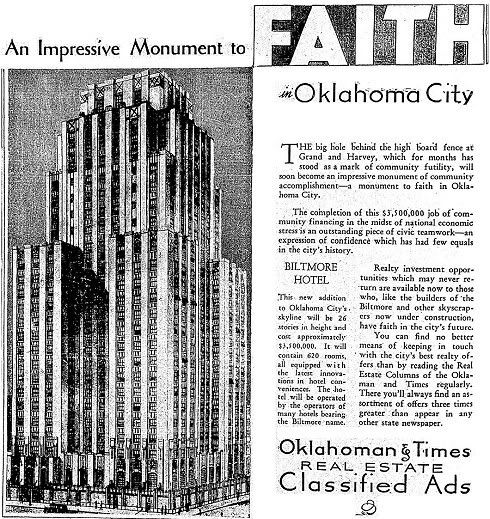
The steel structure topped out in August 1931 and construction proceeded apace. But even as late as February 26, 1932, only days before the hotel's planed March 8, 1932 opening date, financing remained incomplete and a drive to sell preferred stock in the hotel's operating company continued. Finally, on March 4, it was complete. How it all got done in the Great Depression, by this time hitting Oklahoma City and forcing a scale-down of the Skirvin Tower Hotel, is a wonder, but it did get done, and the hotel opened as planned. Reinhart & Donovan's May 8, 1932, Oklahoman appears below (larger image not available).
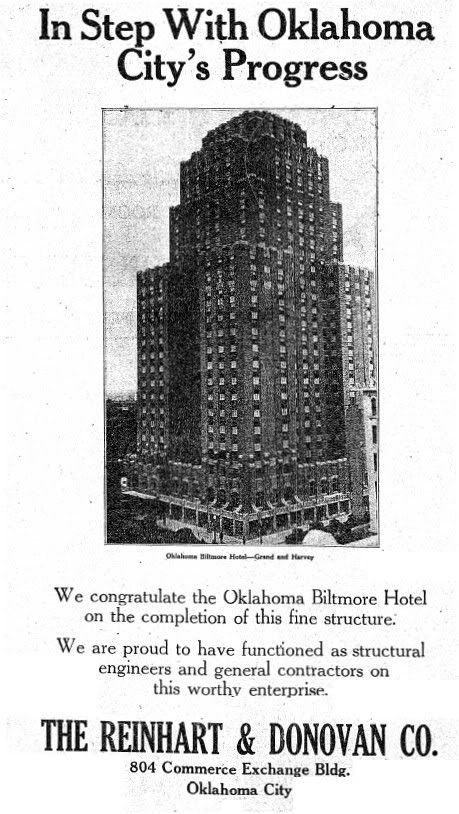
On this day, it became Oklahoma's largest hotel.
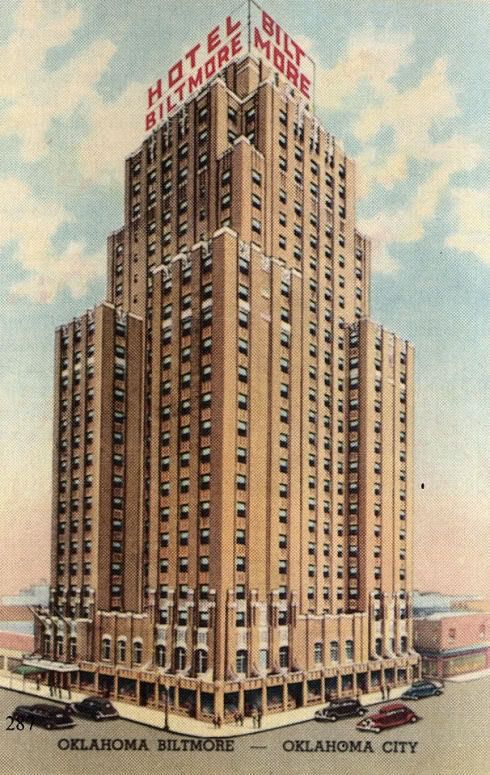
By 1937, the Oklahoma Hotel Building Company was the sole owner of the hotel and Martin was president, and, in 1943, it assumed full operation of the hotel. Plans were announced in October 1945 for an expansion to include an 8-story convention center, and, as far as I know, that was done although I located no Oklahoman articles saying so. In February 1960, a 99-year lease was negotiated with Dan James, then owner of the Skirvin, to operate the hotel property, but that didn't work out. In April 1961, the ownership group signed a 99-year lease and purchase option with the Sheraton Hotel Company and it ceased being the "Biltmore" and instead became the "Sheraton Oklahoma," but that came to an end in 1969. After Martin's death in 1969, his son, John, became the majority stockholder in the company that owned the hotel. Without detailing anything further, suffice it to say that on October 16, 1977, the Biltmore, once Oklahoma's largest hotel and a source of hope through the Great Depression, was imploded in that time's Urban Renewal. For a good bit more about the Biltmore, see this earlier Downtown Hotels article.
The Biltmore Hotel was the last major Reinhart & Donovan construction project in Oklahoma City that I've located, but a few other buildings were constructed in the latter years of the company's construction period such as the Sunshine Laundry shown below.
This building exists today at the southwest corner of NW 1st & Classen Boulevard. However, Classen Boulevard did not exist at that location until November 1952 and the intersecting north/south street in years before that would have been Ollie. The first mention of the address "1000 West 1st" and/or "Sunshine Laundry" at that location in the Oklahoman's archives is August 1, 1934. Before the move to NW 1st, Sunshine Laundry was located at 715 N. Hudson, but I have not found when the move occurred. The Oklahoma County Assessor's records show the address as 1012 NW 1st and that the 17,000 square feet building was constructed in 1929 but I am unable to locate any Oklahoman references to this building before 1934. Today, the building is boarded up.

The Building in June 2008
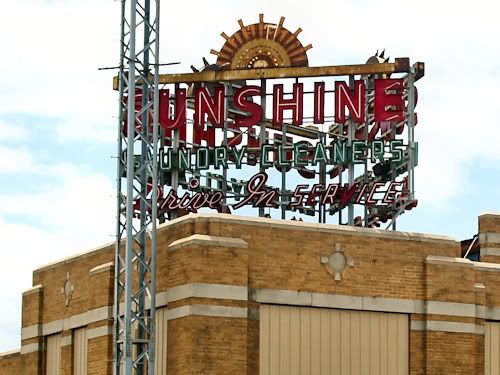
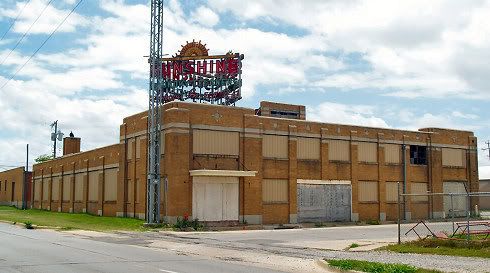
Other Reinhart articles: Part I, Introduction; Reinhart Legacy Part 3, Churches; Part 4 focuses on Theresa Reinhart Dolan, Oklahoma City teenager in the 1910s.














6 comments:
Tried to email you, but can't get past the log.net stuff...love the Reinhart Legacy 1 & 2..Your historical data will keep me occupied for years. I wanted to email you because I married M.J.'s youngest daughter, Helen, 65 years ago (still togethr and in love), worked for R&D '46 to '70, general manager '52 to '70.
Joe Emrick
Joe,
Sorry the e-mail stuff messed you up. You should be able to click my "Avatar" and it should take you to an area where you can send me an e-mail, if you want. I'd post the e-mail link here, but that would be good karma for spammers and bad karma for me! That said, my telephone number is in the phone book and I'd be glad to talk with you and maybe get some stuff to add to this series of articles before it's done! Yes, there is MUCH more to come on this family!
Thank you for your time and effort. Very interesting informatin. I am M.J's Great Grandson. His Daughter Mary Amelia is my Grandmother. She just had her 90th Birthday in May, and she is doing fine in Ada. I can give you her # if you send me an email. john.engel@us.army.mil
I am currently in Iraq as I am an Officer in the Army, but I do check my emial often. Thanks
Thank you for your time and effort. Very interesting informatin. I am M.J's Great Grandson. His Daughter Mary Amelia is my Grandmother. She just had her 90th Birthday in May, and she is doing fine in Ada. I can give you her # if you send me an email. john.engel@us.army.mil
I am currently in Iraq as I am an Officer in the Army, but I do check my emial often. Thanks
I am Barbara Engel, daughter of Mary Amelia Reinhart Engel, who was M. J. Reinhart's daugher. She died February of this year at the age of 90. She had the same sharp mind her father had, and kept it until she died. She was a graduate of Oklahoma University, and at one time aspired to become an engineer and would have been a good one. Her father said he would train her, but she married instead, and applied her intelligence to raising 11 children and working in the family business which was farming and real estate. I talked often to her about her father and her years of growing up in OKC, and can clarify a few things for you. My great grandfather John Martin Reinhart did help to back my grandfater's company. He sold his hardware store in Iowa, and came to OKC with about $100,000, a large sum of money for that time. His partner, Mr. Donavan was not active in the business for long because he had a serious stoke at an early age, perhaps in his forties, which left him disabled. I remember my grandfater as a cultured man who loved to listen to classical music and collect art. I own a baby grand piano from 1936 which he bought for the children to practice on. He also like to fish, and I know he made some trips to the Texas coast to go deep sea fishing, but I think he mostly worked. He did not like to drive, and had a driver most of the time. My mother was comfortable with cars, and began driving at age 10, running errands for her parents, and often driving them around. One of the cars they owned was a huge car with bulletproof glass that "Machine Gun" Kelly's lawyer received in part payment for his defense. It would go very fast, but my mother said she always drove it very slow. Ironically, my grandfater eventually gave it to a group of nuns to drive.
She said her father, though short (maybe 5' 4") was very athletic and a champion bicylist as a young man, and designed a track on his father's farmland in Iowa. He could pick corn very fast because he was just the right height to pick the ears of corn. He contracted to pick a field of corn with a farmer and finished it in such record time the man did not wish to pay him as much as he agreed, but finally did.
My mother said that my grandfater survived the depression by turning over the entire check he received from a few oil wells he owned. He took it to the bank, and and they never foreclosed on his properties. As his situation improved, he took over notes the bank held on other properties, thus increasing his holdings. He always lived modestly, and my mother said the depression left a lasting impression on him.
These are just a few remembrances I have of my grandfather; not important really, but they just make him more real and human. Thank you for all the reasearch you did on him. I really had no idea he built so many significant buildings. Your blog is very interesting. I am now a Texan at cutaway1@people pc.com.
Barbara L. Engel
What a great comment, Barbara. I'll send an e-mail to Norman Thompson who got me started on this series ... if you want to e-mail him yourself, send me an e-mail (click on my icon and you'll find it) and I'll get it to you.
The Reinhart series isn't done ... I've just not gotten back to it. There will be some very nice stuff in Theresa Reinhart's part, particularly.
Post a Comment